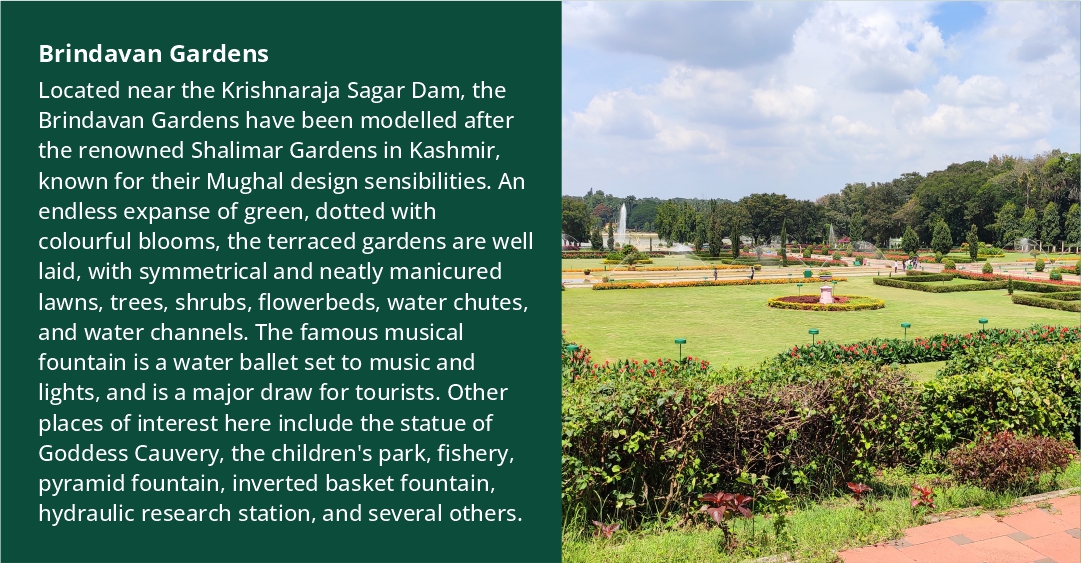Mysuru, Karnataka
Been there recently?
For nearly four centuries, from 1399 to 1947, the city of Mysore (also spelled Mysuru) in the Indian state of Karnataka served as the capital of the Kingdom of Mysore. It is tucked away at the foot of the picturesque Chamundi Hill. The numerous monuments that dot its grounds are a testament to its rich royal past. The lavish Mysore Palace, home to the former ruling Wodeyar dynasty, adorns the city’s core. The palace combines Rajput, Islamic, Gothic, and Hindu architectural styles. In Mysore, there is also the historically significant Devaraja Market, which offers sandalwood, silk, and spices. The city is a fusion of the old and the new, with its well-preserved small-town charm found in its palaces and thoughtfully designed gardens. It also places a high value on spirituality, as evidenced by the numerous temples, churches, and mosques that can be found here. The majority of its buildings are painted ivory, earning it the nickname “Ivory City,” and it is a popular travel destination for contemporary tourists. Mysore is said to have derived its name from the word “Mahishur,” which means “the home of Mahishasura.” Although the city has undergone significant modernization, it still retains a strong connection to its historical roots.
Nearby Places to See
Mysore Palace
Mysore Palace, also known as Amba Vilas, is a three-storeyed architectural marvel in the city’s commercial hub. A gorgeous amalgamation of Hindu and Saracenic architectural styles, incorporated with elements of Neoclassical, Indo-Islamic and Gothic styles, the palace boasts two huge durbar halls, well-laid out gardens, and sprawling courtyards. Almost one hundred thousand light bulbs are used to illuminate the palace on special occasions like Dasara and on Sundays, leaving the entire city bathed in light. Henry Irwin, the architect of the Wodeyar dynasty’s palace, oversaw its construction.
Mysore Palace, also known as Amba Vilas, is a three-storeyed architectural marvel in the city’s commercial hub. A gorgeous amalgamation of Hindu and Saracenic architectural styles, incorporated with elements of Neoclassical, Indo-Islamic and Gothic styles, the palace boasts two huge durbar halls, well-laid out gardens, and sprawling courtyards. Almost one hundred thousand light bulbs are used to illuminate the palace on special occasions like Dasara and on Sundays, leaving the entire city bathed in light. Henry Irwin, the architect of the Wodeyar dynasty’s palace, oversaw its construction.

Sri Chamarajendra Zoological Gardens
The Sri Chamarajendra Zoological Gardens, also known as the Mysore Zoo, were founded in 1892 by Chamarajendra Wodeyar, then-ruler of Mysuru. The purpose of this zoo was to educate the people about the rich wildlife of the state. The zoo was started in an area of 10.2 acres and is now spread over an area of over 157 acres. There are over 150 species representing more than 25 countries at the zoo.
The Sri Chamarajendra Zoological Gardens, also known as the Mysore Zoo, were founded in 1892 by Chamarajendra Wodeyar, then-ruler of Mysuru. The purpose of this zoo was to educate the people about the rich wildlife of the state. The zoo was started in an area of 10.2 acres and is now spread over an area of over 157 acres. There are over 150 species representing more than 25 countries at the zoo.



Sri Chamundeshwari Temple
The Chamundi Hills, where the Goddess Chamundeshwari, patron deity of the Mysuru Royal Family, resides, are 12 kilometres from Mysuru. The 17th-century Chamundeshwari temple, which was constructed in the Dravidian architectural style and features a lavishly attired image of the deity, also has a large statue of Mahishasura close to the entrance. The hilltop also houses a Mahabaleshwara Temple from the Ganga era. On this hill, the goddess is said to have fought and defeated the demon king Mahishasura. Halfway up the hill is a monolith called Nandi, widely considered to be the largest in the country.
The Chamundi Hills, where the Goddess Chamundeshwari, patron deity of the Mysuru Royal Family, resides, are 12 kilometres from Mysuru. The 17th-century Chamundeshwari temple, which was constructed in the Dravidian architectural style and features a lavishly attired image of the deity, also has a large statue of Mahishasura close to the entrance. The hilltop also houses a Mahabaleshwara Temple from the Ganga era. On this hill, the goddess is said to have fought and defeated the demon king Mahishasura. Halfway up the hill is a monolith called Nandi, widely considered to be the largest in the country.

Srirangapatna
Tipu Sultan’s island fortress, Srirangapatna, is situated on the outskirts of the city. Located on the banks of the Cauvery River, it has the appearance of an egg. Artistic treasures from the Vijayanagar and Hoysala periods can be found all over Srirangapatna. The Ranganathaswamy Temple, Tipu’s Mosque, Tipu’s Summer Palace, the Wellesley Bridge, and the British Prison Dungeons are the primary tourist destinations. On the banks of the River Cauvery, around 2 kilometres from here, stands the Nimishamba (Goddess Parvati’s incarnation) temple.
Tipu Sultan’s island fortress, Srirangapatna, is situated on the outskirts of the city. Located on the banks of the Cauvery River, it has the appearance of an egg. Artistic treasures from the Vijayanagar and Hoysala periods can be found all over Srirangapatna. The Ranganathaswamy Temple, Tipu’s Mosque, Tipu’s Summer Palace, the Wellesley Bridge, and the British Prison Dungeons are the primary tourist destinations. On the banks of the River Cauvery, around 2 kilometres from here, stands the Nimishamba (Goddess Parvati’s incarnation) temple.


-
Destination



